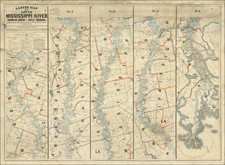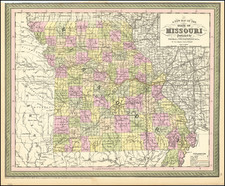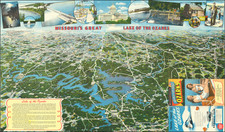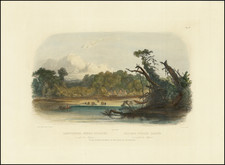With Intriguing Manuscript Annotations.
A handsome example of the 1871 first edition of G.W. & C.B. Colton's "Dollar Series" map of Missouri, one of the premier maps of the state from this period.
Rufus Blanchard participated in the map's distribution in Chicago, and his name is part of the title block.
Perhaps the Colton firm had suffered from inflation, as the price of their "Dollar Series" maps is given as $1.50.
Manuscript Annotations
The map includes manuscript annotations seemingly in several hands, scattered throughout. The prime focus of the manuscript is around the Missouri River, focusing on landmarks that appeared on historical maps of the area (e.g., "Kanzas Village", "Ft. Orleans ?", "Big Rock of D'Anville 1732", "Pyramid", etc.) presumably based on comparison with an earlier 19th-century map of the region.
The map also includes much in the way of drawn-in pencil routes.
Editions
According to Tibbits, this is the first edition of the map (Tibbits 9 0928), followed by editions of 1872 (9 0935), 1873 (9 0941), 1877 (9 0978), and 1879 (9 0999).
Provenance
Minnesota Historical Society deaccession.
G. W. & C. B. Colton was a prominent family firm of mapmakers who were leaders in the American map trade in the nineteenth century. The business was founded by Joseph Hutchins Colton (1800-1893) who bought copyrights to existing maps and oversaw their production. By the 1850s, their output had expanded to include original maps, guidebooks, atlases, and railroad maps. Joseph was succeeded by his sons, George Woolworth (1827-1901) and Charles B. Colton (1831-1916). The firm was renamed G. W. & C. B. Colton as a result. George is thought responsible for their best-known work, the General Atlas, originally published under that title in 1857. In 1898, the brothers merged their business and the firm became Colton, Ohman, & Co., which operated until 1901, when August R. Ohman took on the business alone and dropped the Colton name.
















